


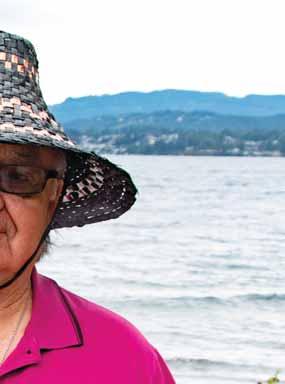







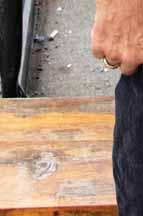

























































































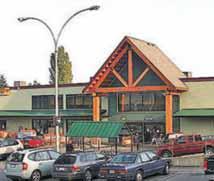



2 take5.ca MARCH2023











4 take5.ca MARCH2023







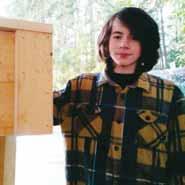




TAKE5 take5.ca 5










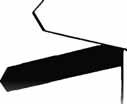














































Letters


Tell Me More! Contest Feb 2023 Issue






The picture in the February 2023 TAKE 5 issue includes a four-piece portable drydock used in World War II to lift damaged ships out of the water to do repairs. The four pieces of the drydock are lowered in the water by pumping water into the cement ballast tanks in each of the four sections. The ship needing repairs is then positioned over the drydock sections. Water is pumped out of the ballast tanks to raise the ship out of the water.



Once repairs are done, the water is pumped into the ballast tanks of the drydock segments to lower the ship back into the water. The four drydock pieces lower, and the ship can pull away. All four segments of the drydock were temporarily stored near the Maritime dock. Although all four pieces were intended to be used as promenade in Chemainus, only one segment was sunk in Chemainus Harbour and is currently being used as a breakwater. The remaining three pieces of the drydock were returned to Ladysmith Maritime dock area and then dismantled by the Provincial Government at Slack Point.
If you are walking out at Slack Point, you can still see the large chunks of the cement ballast from the drydock in a large
TAKE5 take5.ca 7
pile. The picture is showing the drydock segments next to Ladysmith Maritime Society in a location that is referred to as Dog Patch . - Tom Skarvig

Letters to the editor on community topics and concerns are welcome. Opinions expressed here do not necessarily represent those of TAKE 5 and its affiliates. Please send letters to editor@ take5.ca or via Messenger on Facebook.












8 take5.ca MARCH2023









TAKE5 take5.ca 9


Affordable housing building
The Heart on the Hill is beating.

And the Ladysmith Resources Centre Association (LRCA) is celebrating its new 36-unit affordable housing project with an open house on Saturday, March 25, from noon to 4 p.m. Ribbon cutting is at 2 p.m., followed by refreshments and music by Peace Love Joy Band and Ladysmith Brass.

The long-awaited housing project construction is fi nally ending, with just some landscaping and paving left to do, according to LRCA President Sandra Marquis. And yes, they are accepting rental applications for the 36 units. Four are studio units, 27 one-bedroom units, and five are two-bedroom. Some units are designed to be accessible to those with mobility challenges.
At the heart of the project, and Marquis’s favourite features are the community kitchen and a multi-purpose area that can be booked by residents, used by the LRCA for programs and made available for community use. “This space will bring the tenants together and help build community. This is unique among most housing projects currently devel-
oping in BC.”
The project addresses the need for affordable housing in Ladysmith, fi rst identi fied in a 2014 Delphi report by the LRCA and growing worse since then.

This is the LRCA’s fi rst big housing project. The LRCA offers many programs and services, but housing is a new enterprise for them. While it has been a steep learning curve, with challenges along the way, Marquis is proud of what the LRCA has accomplished in partnership with the Town of Ladysmith, Anglican church, CMHC, BC Housing and many community members.
As Anna Zhou of CitySpaces, a development consultant on the Heart on the Hill project, says, “It is indeed worth celebrating!”

Poverty reduction workshops

The Town of Ladysmith is hosting several key events in March where residents can learn more about the complex realities of living in poverty, food equity and cultural safety to help in moving forward with local solutions.
The Town’s Poverty Reduction Task Group invites the community to participate in these free events.
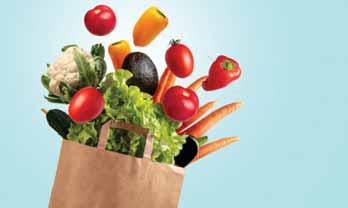
12 take5.ca MARCH2023
LRCA President Sandra Marquis in front of the Heart on the Hill Project.
Photo: Marina Sacht
Journey of Our Generation, Cultural Connections workshops: Taking place for a full day on Thursday, March 9, 2023, and a half day, follow-up session on Thursday, March 30, 2023, these workshops aim to build awareness and understanding about the truth of our colonial history and the ongoing impacts on Indigenous peoples.
The fi rst workshop will focus on the systemic impacts of our colonial history shared through personal stories from Indigenous Elders who are residential school survivors.
The second workshop will focus on examining the current reality of how Stz’uminus First Nation and Ladysmith are divided and how we can all take action in our personal and professional areas of in fluence to work and live better together, hw-nuts’-ulwum (as one).
Neighbours Sharing Food Event: This event on March 25, 2023, highlights the importance of local food security and is an opportunity to learn about growing, cooking and preserving food as well as overall access to local, healthy food.
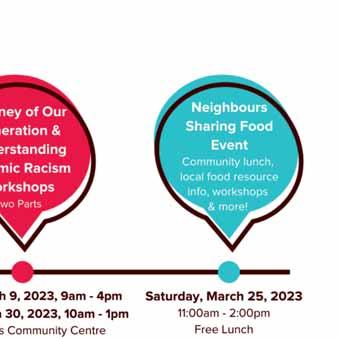

Come share a meal, attend a workshop and watch a demonstration by local chefs cooking a delicious meal entirely from ingredients found at the Ladysmith Resources Centre Association (LRCA) Food Bank.
Council created the Poverty Reduction Task Group last year to lead the implementing of the Ladysmith/Stz’uminus CommUNITY Together to End Poverty Hw-nuts’-ulwum (as one) Poverty Reduction Strategy as a result of funding received from the Union of BC Municipalities (UBCM).
The Council-endorsed strategy was created through extensive public consultation and identi fies poverty themes and recommended action items.
NOAHS Museum opens

North Oyster and Area Historical Society’s Museum and Archives is reopening on Sunday, March 5, and March 19, 2023 from 10 to 2pm. They will continue to be open every other Sunday. Admission is free and volunteers are always welcome. For more information call Irene at 250-245-2559.

TAKE5 take5.ca 13
Community to End Poverty dinner and fi lm night in February.
Canadian Stick Curling Championship
On Feb. 18, 2023, the Nanaimo Curling Centre held an Open House and participants were treated to a demo game to try out the stick curling. Amongst the dignitaries was Ken Best, who’s better known as “Lefty.” Now age 93, he is credited with helping to bring the sport to Nanaimo.
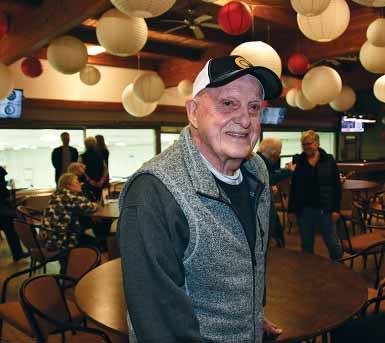
Brian Scorer recalls that about 25 years ago there was a curler in Nanaimo that threw the stone by using the brush end of his broom. Lefty thought this was a great idea and so he spoke with his friend Ted Chapel (who has since passed away). Ted went to his shop and made his version of a “stick” for him and Lefty of course used it immediately and for the time he remained curling.
”I remember curling with both of these guys years ago and they were the very best of people both on and off the ice—friendly and always ready for a laugh. They both curled in the Sunday Hangover League for a long time.”
The NCC is hosting the 17th Annual Canadian Stick Curling Championships on March 30 to April 2nd. 72 teams from across the country will be competing, the event is open to the public to watch at no charge. For more information contact Mary Ellen Konyer, President NCC and Event Co-Chair president@nanaimocurlingclub.ca or Debbie Erdos, Promotions/Social Media Committee, 2023 Canadian Sticking Curling Championships erdos.debbie@gmail.com
Ladysmith Fire/Rescue Ladder Truck to be acquired by CVRD
Ladysmith Fire/Rescue’s (LFR) Ladder 1 truck will fi nd its new home in North Oyster after serving our community for 25 years.
Ladysmith Council is waiving the Town’s Purchasing Policy to permit the sale of the 1997 Superior Ladder Truck to the Cowichan Valley Regional District for $30,000, plus taxes. The truck will be used by the North Oyster Volunteer Fire Department.
“The CVRD’s purchase of Ladder 1 is a fantastic outcome for the residents of Ladysmith and Area H (Diamond, North Oyster, Yellow Point),” says Ladysmith Mayor Aaron Stone.
“Through the Mutual Aid Agreements among Cowichan Valley fi re responders, this asset will continue to be available to our neighbours and increase our collective ability to address emergencies in our region.”
Ladysmith’s new Sutphen SPH100 Mid-Mount Aerial Platform truck is now being used by fi refighters during weekly training and replaces the 1997 Superior Ladder Truck.
The new vehicle features a 100-foot ladder with a platform bucket for optimal safety and rescue capabilities when working at heights.
As a result, the addition of Ladder 1 to the North Oyster fleet will also now grow the total number of aerial devices available if required for a major fi re event in the local area.
Easter Egg Hunt returns
The Ladysmith Lions Club is excited for the return of the Easter Egg Hunt. That is right! It will be returning to Transfer Beach on Saturday, April 8, 2023, starting at 10:30 pm.
It has been a few years since the Ladysmith Lions have had the Easter Egg Hunt due to COVID restrictions. The event has been very popular and has attracted hundreds of children over the years. The Easter Bunny has con fi rmed a good supply of mini wrapped chocolate eggs and will be on hand for the event. The Lions will on site to serve up warm drinks for the participants.
This event is open to children eight years of age and under. Please bring your own basket to collect the eggs.
In-Person grief support now available in Ladysmith
Until recently, a Ladysmith resident seeking hospice support had to drive to the Duncan office for an in-person meeting. For many, however, driving to Duncan is inconvenient or impossible, and connecting by phone or video isn’t a good fit.
To better serve the community, Cowichan Hospice has opened a small satellite office in Ladysmith so that those who can’t travel to Duncan can still take part in one-to-one, private in-person appointments. Appointments are available Wednesdays and Thursdays from 9-2 pm.
Hospice intends to develop services in Ladysmith further, including groups and workshops as the need arises.
Cowichan Hospice serves individuals with serious illnesses, but did you know that the same emotional and practical support also extends to caregivers and those grieving the death of a loved one? These services are con fidential and free of charge for anyone in Cowichan. To learn more call 1-888-701-4242 or visit www.cowichanhospice.org.
RDN receives $150,000 for Geohazard Risk Prioritization Study
The Regional District of Nanaimo (RDN) has received approval for a $150,000 grant from the Government of British Columbia’s Community Emergency Preparedness Fund, Disaster Risk Reduction – Climate Adaptation stream to conduct a geologic hazard (geohazard) risk study.
Adapting to a changing climate requires a better understanding of the risks related to geohazards in the region. Geohazards are events caused by a combination of natural processes that are potentially dangerous or present a threat to lives, property, infrastructure and the environment. Due to our local geography and a changing environment, geohazards pose a risk in some areas of the RDN. The geohazard study will determine the locations and level of risk associated with landslides to help reduce potential current and future impacts on residents.
“The Regional District of Nanaimo is greatly appreciative of the grant pro-
14 take5.ca MARCH2023
“Lefty” Ken Best at the Nanaimo Curling Club. Photo: Marina Sacht
vided by the Government of British Columbia,” says Vanessa Craig, RDN Chair. “The study outcomes will help our region be better prepared and more resilient to the effects of a changing climate.”
The study will describe and prioritize steep slope and landslide hazards, primarily in the electoral areas.
The RDN will share the fi ndings with local government officials and development professionals to help inform their decisions related to land use planning, such as sustainable site planning, emergency readiness planning and future infrastructure investment. The study will also provide vital information residents can use to prevent or reduce the risk of local geohazard events.
The study will take two years to complete and will add to the RDN’s online resources on natural hazard information in the region.
For information on completed coastal and river flood hazard projects, including maps, visit rdn.bc.ca/flood-managementprogram.
For those who live in or near flood-prone areas, the RDN has a wide range of emergency preparedness resources available at rdn.bc.ca/flooding.
Spring Clean Up set to return April 11–17, 2023
The Town of Ladysmith is excited to announce that our annual Spring Clean Up is scheduled for Tuesday, April 11–17, 2023.
The bulk item door-to-door pickup carried out by our contractor Waste Connections assists residents with discarding common household items such as furniture, mattresses, children’s toys and barbecues.
As a sustainability leader, the Town is pleased to be able to collaborate with residents on reducing the impact solid waste has on our environment.
Spring Clean Up is limited to the select items listed above due to the sorting requirements to efficiently divert items away from the land fill, taking advantage of initiatives provided by the Cowichan Valley Regional District.
You can do your part to help us by sorting items such as metals into one pile. Additionally, mattresses, rugs and carpets must be fully contained in plastic and be sealed in order for them to be collected.
Additional items placed at the curb during Spring Clean Up will unfortunately not be collected by the Town’s contractor.
Transfer Beach Park improvements
As part of the Town’s receipt of Provincial Tourism Funding, improvements at Transfer Beach Park are in the fi nal phase. The project will improve accessibility with the installation of concrete walkways connecting the park’s amenities as well as supporting beach access for those with mobility challenges.
A bike repair station, bike racks and new concrete patio tables as well as modi fications to the food truck vendor space are included.
Most recently over the summer, the Town completed an addition the public washroom building, enhancements to the Kinsmen and Sportsmen picnic areas and a shelter over the Salish Wind canoe. Construction is scheduled to be completed by the end of March 2023.
Fourth Avenue reconstruction
The Town has retained Hazelwood Construction to complete the reconstruction of Fourth Avenue between White Street and Root Street over the next several months.
Construction commenced in mid-January 2023, with completion planned in early Fall 2023.
The contractor is removing and replacing existing underground and surface infrastructure within the municipal rightof-way. This includes replacement and upgrading of sanitary sewer, storm sewer, water main, pavement, streetlights and intersection improvements at Fourth Avenue and Belaire Street.
State of the Cowichan Economy Report


highlights the latest trends in our region


Economic Development Cowichan (EDC) has published the second edition of the State of the Cowichan Economy report. This series highlights the latest data and economic trends for the Cowichan Valley Regional District, and is published twice a year.
In the second State of the Cowichan Economy report, EDC highlights more Census 2021 data as well as information on the living wage, job vacancy rates and house prices. The data shows changes in our labour force, including a rise in working from home and a higher proportion of jobs in health care and construction while retail, accommodation and food services saw declines.
Tjey are also starting to see the housing market cool, with benchmark prices now three per cent lower than the same time last year, but still 67 per cent higher than five years ago.
TAKE5 take5.ca 15
“The link between housing and the labour market is of particular interest to us,” says Barry O’Riordan, manager of Economic Development Cowichan.

“This report shows a continued labour shortage in our region. That coupled with an insu fficient supply of affordable housing means many prospective workers are struggling to fi nd suitable places to live in Cowichan.
In response, EDC has launched a Workforce Housing Strategy project aimed at developing solutions to the housing crisis as it relates to employment.”
The dashboard reports are available on the EDC website where you can fi nd further details and resource. Visit ecdevcowichan.com.
BC Transit BC’s Top Employers for 2023
For the third year in a row, BC Transit has been recognized for its exceptional workplace as one of BC’s Top Employers for 2023. BC Transit has more than 1,000 employees with a wide range of careers that include drivers, maintenance and administration.
“It’s an honour to be recognized as one of our province’s top employers, for three years running,” says Erinn Pinkerton, BC Transit president and chief executive officer. “BC Transit prides itself on being a diverse and engaging workplace.”
BC’s Top Employers is an annual competition organized by the editors of Canada’s Top 100 Employers.
To fi nd out more visit https://canadastop100.com/bc/
16 take5.ca MARCH2023
Water connection applications start flowing
BY KERITH WADDINGTON
An 11-year moratorium on new water connections in the North Cedar Improvement District (NCID) has been lifted. Since then, 10 single-family homes and seven secondary suite applications for water connections have been made. And many more are expected.
The moratorium had been in place since 2010 due to a water supply and storage issue. It was lifted in September of 2021 because the new NCID water reservoir and treatment plant, located at 1723 Cedar Road, was due to become operational in April 2022.
The reservoir holds 4,000 cubic meters, and the state-of-theart treatment plant beside it boasts not one but three levels of treatment, ensuring that the water coming out of the plant adheres to strict provincial drinking water protection guidelines.

Together the reservoir and treatment plant increase water storage capacity for the NCID, improves drinking water quality and decrease any health risks.
It is the epitome of a win-win, says Stephen Dives, Board Chair with the NCID.
“Not only that, but the only treatment of the water was chlorination. Now not only do we have ample capacity built to meet projected demand in the District for the next 30 years, but we
have a much more rigorous water treatment process. So this reservoir and treatment plant are a great step forward for the people of the District,” says Jennifer Bradley. NCID Administrator.
The NCID is a 30-square km area that includes from Tiesu and Gould to Harmac and Cedar Roads. Within this area, there are about 5,000 residents and close to 1,300 water service connections.
A connection is a metered service to a building or property, but one connection can have multiple units.

The Cedar Road plant treats raw water from three existing wells located on the property and includes new systems that reduce the risk of waterborne pathogens entering the distribution system.
The fi rst of those systems is to change the pH of the water to neutral and use direct filtration to address turbidity.
Next, ultraviolet and chlorination are applied to kill viruses and parasites that may be in the water.
The treated water is then discharged into the new storage reservoir and ultimately into three distribution pumps to supply the distribution system for regular water use and fi re flow.
Money from the NCID reserves and a loan paid for treatment plant construction. District bylaws are in place to manage new connections to the system, although anyone is eligible if they meet bylaw requirements and have the correct zoning/approval through the RDN for the proposed development.
TAKE5 take5.ca 17
NCID’s Chair Stephen Dives and Administrator Jennifer Bradley. Photo: Kerith Waddington
YPDG presents Spring Shorts

Yellow Point Drama Group presents “Spring Shorts” running March 24 to April 9 at the Cedar Community Hall. The production features three dynamic short plays filled with humour and heart.

The fi rst is “The Ugly Duckling” written by Winnie the Pooh creator A.A. Milne. The fairy tale fable follows the story of a royal princess whose parents, the king and queen, are desperate to see her married off. Unfortunately a family curse has caused suitors to see her as being plain, until one day a travelling prince sees her for what she truly is.
Next up is “On Ice” by local play-

wright Gordon McInnis. The setting is a hockey arena as an ardent Canucks’ fan takes the seat next to a man whose mind is elsewhere. The cheering fan and the preoccupied man eventually fi nd they have more in common than just the game.
The third play is by another local writer, Barrie Baker. “Departure Lounge” features two women with family Christmas plans waiting to board their flight. Their chance meeting soon leads them to rethink what they really want to do over the holidays.
This entertaining theatrical event has something for everyone, and we invite you to join in the experience. From March 24 to April 9, shows are Friday, Saturday evenings, doors open at 7 p.m. and curtain at 7:30 p.m., with Sunday matinees, doors open at 1:30 p.m., curtain at 2 p.m. Advance tickets available at yellowpointdramagroup.org or by reservation at 250-722-2459. Tickets may also be purchased at the door by cheque or ash (Adults are $25; students, $15).
What’s Happening



 BY ELLY SMITH
BY ELLY SMITH
Looking for a little entertainment this month? The good news is that you have lots to choose from.
The Ladysmith Legion is going to be the happening place for music this month with the Cowichan Reggae Society Fundraiser on March 18 featuring Sasquatch Sound at 8pm, and on March 25 enjoy a Spring Dance & Blues party with the Mark Crissinger Band at 8pm.



The Port Theatre in Nanaimo has a fantastic line up presenting the Nanaimo Conservatory of Music talent Ian Parker for his piano solo concert on March 12 at 2:30 pm and if you want a stroll down memory lane be sure to book tickets for The Legends Show – Tributes to Orbison, Connie Francis, Motown and Elvis at 7pm on March 23.
A fun show for the kiddies at the Cowichan Performing Arts Centre in Duncan is A Dinosaur Tale on March 16 at 6:30pm and partake in an evening of sing along with The Rocket Man & The Piano Man: Tributes to Elton John & Billy Joel at 7:30 pm
If you are ready for a laugh, get your tickets to the musical comedy “Naked Radio” opening March 3 to April 2 at the Chemainus Theatre. Picture this… a powerful snowstorm grips the Island, and everyone hunkers down. Sound familiar? Slowly they lose connections to the internet, cell phones and TV. What’s left is the local radio station and two reluctant DJs who fly by the seat of their pants to hold the community together through music, laughter and song, with a host of call-in characters and cheeky jingles. While there, make sure to check out their gift shop and gallery.

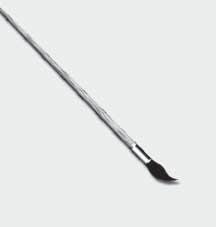
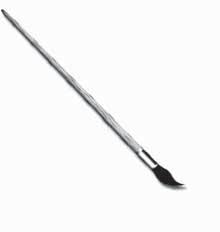
18 take5.ca MARCH2023
Barrie Baker, Departure Lounge playwright. Photo: YPDG
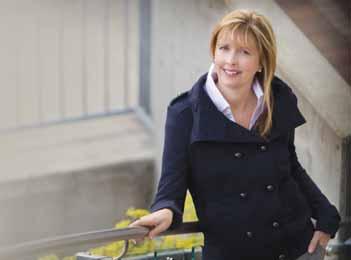

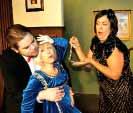












TAKE5 take5.ca 19
Digging for Treasure: Uncovering the History of Local Soda Bottles
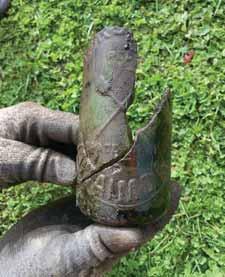 BY DALYS BARNEY
BY DALYS BARNEY
It all started with a Rumming soda bottle dug up in the older part of Ladysmith. My husband’s crew found it while doing an excavation for work on underground utilities. Then they found another one in a di fferent spot, and another one and another one! And then there was a piece of sea glass found washed up on the beach — incredibly, the distinctive pick and shovel embossing was still visible.
My dad is a bottle collector, with a particular interest in local bottles, so I had seen the crossed pick and shovel logo before. But all those recent fi nds got my curiosity fi red up. I started doing some metaphorical digging, reading anything I could fi nd about local soda bottles. It turned out that there was quite a lot of information out there, but bits and pieces of it were in all different places, and some of it con flicted or just didn’t make any sense. Did William Rumming come to Canada with 20 years of bottling experience when he was only in his 30s? How come John Mitchell’s time in the industry was dated to 1897 when he died in 1895? The history nerd in me needed to know more!
At fi rst I thought that I would write something for my local history blog, VanIsleHistoryExplorer.ca, but once I started researching and then writing about the history of Nanaimo’s soda industry, I knew this was going to be something more than just a blog post or two.
While defi nitely popular in their day,


the two volumes of Western Canadian Bottle Collecting had come out in the 1970s and Bill Wilson’s Pioneer Soda Water Companies of BC in 1986. Volume 1, Number 1 of Wilson’s Soda Kings of B.C. & the Yukon series is about the Capital Region and does cover some Mid-Island bottles, but that 2019 book is already out of print and available only by arranging an interlibrary loan. It seemed like there just might be a place for another publication about local bottles. Could I really write such a thing? Me?
I had seen Roger Prior’s publication about Cedar-by-the-Sea and Tamara Cunningham’s one about South Wellington, and thought that I could maybe do something similar in size and format about the history of Nanaimo’s soda bottles and manufacturers. I started calling it a “booklet” in my mind because that sounded less intimidating to produce than a “book,” and I also secretly hoped that my minimalist thoughts might help keep the printing costs down. I knew that I wanted to include lots of pictures of bottles, so it defi nitely needed to be a full-colour publication — that sounded expensive.
But help was out there! I was pleased to be supported with a Leynard Legacy Grant from the Nanaimo Historical Society as well as additional funding towards printing costs from the Nanaimo Community Archives. Collectors quietly provided pictures of hard-to-fi nd bottles as long as I promised to never reveal their identities or dig sites. I was also helped with research, editing and photography by multiple people inter-
ested in my project.
My booklet isn’t a pricing guide but an attempt to tell the history of the local soda industry.
Starting as early as the 1870s, Nanaimo had entrepreneurs who were bottling and selling soda in the city. A small luxury that could be enjoyed by the young and old alike, bottled soda was especially welcomed at well-known Nanaimo summer events, like the miners’ picnic. While independent local soda businesses have faded away with time and industry consolidation, what we’re left with today are the bottles, some of which feature iconic Nanaimo images like the crossed miner’s pick and shovel or the Bastion.
While I’m aware that beautiful siphons were used by hotels and wealthier families and that stoneware bottles were sometimes used for ginger beer (and that both of these bottle types are highly collectable), I focused on what I think of as the soda bottles of the everyman — single-serving glass bottles that would have been bought and used locally by folks in the Mid-Island region.
With my booklet, Message on a Bottle: Nanaimo’s Soda History, I did my best to put together a plausible timeline using information gleaned from previous publications, newspapers, BC city directories, records from genealogy databases, interviews with descendants of company owners and bit of guesswork. Any mistakes are mine, and I’m happy to be corrected or enlightened further.
Early Nanaimo manufacturers like William Rumming, John Mitchell and Louis Lawrence are featured in the booklet as well as later companies like Island Bottling and Nanaimo Bottling Works. There were also Ladysmith, Courtenay and Port Alberni connections. William Rumming opened a bottling plant on First Avenue in Ladysmith in the early 1900s — which is one likely reason why so many bottles have been dug up in town. However, I’ve heard reports of Rumming bottles found as far away as Caycuse outside of Lake Cowichan.
Since self-publishing the booklet, I’ve had quite a few people reach out, some with additional information that I just didn’t come across in my research, but people also shared pictures of their own bottle collections. If I ever want to do a second edition, I already have more con-
20 take5.ca MARCH2023
tent to work from.
There’s just something about digging up bottles that really appeals to the treasure hunter in a lot of people. It was a really interesting project to work on, and although I’m not much of a bottle collector myself (not yet anyway), I really enjoyed learning more about another historical aspect of the local area.
I will be setting up a table, selling booklets and hoping to chat more about bottles, at the North Oyster and Area Historical Society’s museum, reopening on Sunday, March 5, as well as at the upcoming South Wellington Heritage Day this spring. I’ll also be speaking to the Nanaimo Historical Society at their AGM on Thursday, March 9.






Message on a Bottle: Nanaimo’s Soda History is available for $10 if I can connect with you locally in the Nanaimo–Ladysmith area, or $12 if you would like a booklet mailed to you. Copies are also available in the giftshops of both the Nanaimo and Ladysmith museums.




TAKE5 take5.ca 21
Author Dalys Barney with her father’s soda bottle collection.
Photo: Martin Barney.
Heritage Awards
The fourth annual Ladysmith & District Heritage Awards Ceremony was held on February 26, 2023, via Zoom. The awards celebrate the recipients and their work in the community and are presented by the Ladysmith & District Historical Society and the Town of Ladysmith.
“I often say our past informs our future,” said Ladysmith Mayor Aaron Stone, who presented the awards alongside LDHS president Quentin Goodbody. CVRD Area H Director Ben Maartman also attended.
First up was Daryl and Donna Beeston, with special mention to Brian Childs & Company for the restoration of 32 White Street, one of the houses relocated from Wellington to Ladysmith in the very early 1900s, which is a signi ficant element of Ladysmith’s built heritage. “When dad passed away, and mom was left with the house by herself, she realized that it was a little more than what she could handle, and she was really thrilled when one of her children was willing to take it over,” said Daryl Beeston. During the renovation, they discovered a date on the bottom of the tub that read 1904. But likely, the house is even older than that.
Bill Drysdale and Chuck Forrest were recognized for their pioneering efforts in maintaining the E&N Train Station and grounds along a pathway connecting the waterfront to downtown. Once the pathway had been cleared, they realized that the station building, which essentially had been abandoned since the end of rail service in 2011, had the potential to be a signi ficant asset to the community. And they set about clearing trees and brush, and that started the momentum to clean the building up and preserve it.
“It’s good to sit around talking about it, but sometimes you just have to get up and do something about it.” recalled Drysdale, who recently moved to Alberta to be closer to family.
Forrest lives in Parksville, yet he still stayed involved with the Ladysmith community. “I think the rail station has a lot of potentials. If we can bring more people into Ladysmith to see the heritage side of it, then it’ll benefit all,” said Forrest.
Artist and carver Jason Harris was
acknowledged for his exquisite street banners, which in 2022 showcased Stz’uminus art in Ladysmith and for enhancing awareness and appreciation of Coast Salish culture through his art.
“Hummingbirds are probably the most famous of all my carvings,” said Jason Harris, who will soon be carving his biggest hummingbird yet at six feet height for the Nanaimo Airport that will be hanging at the entrance.
Also awarded was the Parents Supporting Committee 257 Royal Canadian Air Cadets Squadron for ensuring the squadron’s long-established place in Ladysmith’s Community Identity and for its role in the preservation and centenary celebration of the Agricultural Hall.
Sitting chair of the Ladysmith Air Cadets, Mark Stewart, accepted the award and thanked the community for supporting the Cadet program and invited the public to help them celebrate the cadets’ 80th year anniversary in the Aggie Hall this April.
The final award went to Elder George Harris (Whul’qul latza) for composing “Stz’uminus Mustimuxw” and his tireless advocacy of the Stz’uminus and Coast Salish Nations.
George is extremely active within his community. He is a Naut’sa mawt tribal council elders council member. George also is a founding member and current vice president of Tsow-Tun Le Lum Society, which is also called Helping House, and he is a member of the National Elders Working Group Committee of Correctional Services Canada.
In 2010, George wrote the song as part of the 2010 Olympic torch relay celebration. He recalled singing it for the fi rst time in his community and the emotional effect it had. “No one’s going to wonder who we are when we sing this song.” The song has been adopted by Stz’uminus as the Anthem song, and it’s been sung everywhere.
“It has great meaning to me in our language because of the culture and traditional practices that we have and the beliefs that we have, as well as our teachings,” he said.
“I’ve never known somebody to be so supportive and caring in helping us understand and come together through his songs, his guidance and leadership at the events within our community,” said Stone.
49th Parallel Grocery Stores open house
A group of appreciative individuals is hosting a Community Thank You to the Richmond family of the 49th Parallel Grocery Stores event on Saturday, March 11, at the Aggie Hall. They invite the public to join them in thanking the Richmond family for their community service and spirit that shone through their 49th Parallel Grocery Stores. Starting at 2 pm and going to 4 pm, you can drop in for cake and refreshments and sign the Memory Book.
This event is just one example of the love and respect this community has for the family-run business.
On February 20, Island Buying Group, better known as Country Grocer, acquired the four 49th Parallel Grocery locations in Ladysmith, Chemainus, Cedar and Duncan.
The good news is that the 49th stores have been acquired by a similar-minded family business – and that was a key deciding factor for the Richmonds, who had a multitude of offers to choose from. And consistent with their philosophy, they did not choose the highest bidder but the best fit for their staff and the community.
“We are delighted to see the business become part of a bigger, multi-generational, family-operated grocery business with similar family and community values as 49th Parallel Grocery,” said Peter Richmond, President & CFO of 49th Parallel Grocery.
Founded in 1977, 49th Parallel is a family-run business operating four grocery stores across Vancouver Island.
“Much like the Richmond family, Country Grocer’s operations began as humble beginnings in 1984 here on Vancouver Island, and today is operated by a multigenerational ownership team who will be dedicated to continuing the legacy of quality service to these communities for years to come,” stated Wally Large, co-founder of Country Grocer.
Tyler Large, Country Grocer Operations Director, says the acquisition is a tremendous opportunity and is excited to continue providing customers with quality products, competitive pricing, good service and a commitment to the communities it serves.
The ownership transition is part of the succession plan for 49th Parallel’s share-
22 take5.ca MARCH2023
holders, the Richmond family: Wayne and his wife Harmina and his children Peter and Kathy.
Kathy was 10 and Peter 14 when they started working, sorting bottles, and stocking shelves. It’s been their life.
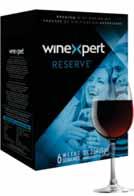
But as Wayne puts it, “the four of us are getting older, and there’s no other generation to take it over with grandchildren following different career paths.”

“I did everything,” recalls said Harmina. “And at nine o’clock at night, I became Carol Brunette because I had to wash the floors.”

“This has been my whole life”, said Kathy, who will continue working there with her husband, Mark.
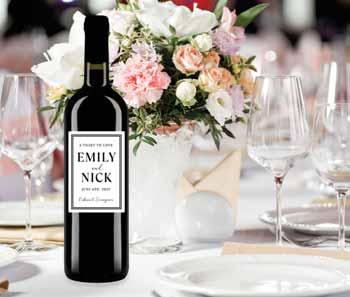
“It’s been an amazing journey,” said Peter, who will stay on during the transition. But when the dust settles, he has plans to expand the corner lot by developing the four lots above the store and five lots on Warren street, giving Ladysmith muchneeded new commercial space.
The Blooms and 49th Café will be part of Country Grocer, but the Richmonds are keeping 49th Parallel Printers and are still the landlords of the shopping centre.


TAKE5 take5.ca 23
Harmina, Kathy, Wayne and Peter Richmond of the 49th Parallel Grocery Stores. Photo: Marina Sacht
Below: 49th Parallel Grocery and Country Grocer executives in front of Duncan store. Photo: Jennifer Blyth / Black Press Media
RDN Area A Cedar, South Wellington, Cassidy & Yellow Point
It’s budget time, folks.
The RDN Board is in heavy discussion about our fi nancial plan and the tax implications for our community. Important contextual considerations are that money is tight for most, costs are rising, and the population is growing. Nanaimo is one of the fastest growing regions in the province, and Area A is no exception. As such, there is more demand for services, and it is getting more expensive to provide those services.
I want the community to understand what is being proposed for the RDN services that your taxes fund. Ideally, community members support how their tax dollars are spent, but we all vary somewhat in our priorities. It’s a delicate balance, and I want to provide information so that the community can give me feedback. Although the publication of the TAKE 5 may not align with the dates that the Board is voting on the fi nancial plan, any feedback received will guide my choices as your representative during next budget season and throughout the year.
The RDN creates a fi nancial plan for the services they provide that is submitted to the Province. The Province collects and distributes tax money to RDN and to other services including education, police and hospitals (which are collected separately). Municipalities have additional and separate taxes for their services. However, Area A is not a municipality. Our RDN taxes pay for general services provided by the RDN (e.g., garbage collection, emergency services, transit) and any specific services relevant to speci fic properties (e.g., those who receive sewer and water services). Due to space limitations, I will focus only on general services here. Speci fic services are taxed separately and only for those who receive those services.
The current proposal for 2023 General Services (GS) Property tax in Area A is $95.44 per $100,000 of assessed value.
This is $7.41 per 100,000 of assessed value lower than last year, partially because property values have increased. The average residential value in Area A is $842,302, which means an average GS property tax of $820 (this varies depending on property value). On average, GS property taxes for the RDN are currently proposed to increase by $81 (depending on the value of your property). There is also a proposed increase of $2 per parcel, increasing the parcel tax to $16 (this funds the Drinking Water and Watershed Protection Program). In total, this is an 11 per cent increase in GS taxes. It should be noted that the original proposal was for a 13 per cent increase, which was lowered given affordability concerns.
The breakdown of these proposed Area A increases follows. Our biggest increase of $16.71* is for Electoral Area Community Planning. This funds two new positions in the planning department, the flood plain bylaw, and a process to modernize permit areas. The new positions will hopefully address some of the permitting delays that have been a community concern. The second biggest increase of $12.06* is for Area A Recreation and Culture in response to the requested and received increase level of recreational service. The next biggest increase is $10.37* for the Vancouver Island Regional Library (VIRL). Although the RDN Board has representatives on the VIRL Board, it is the VIRL Board that determines their budget and not the RDN. Our fourth biggest increase is $10.04* for our regional parks, which funds park and trails projects and increased level of usage. Currently, our fifth biggest increase is our Southern Community Recreation agreement that funds City of Nanaimo sports fields and our access to them. I am told that this increase is expected to go down signi ficantly, but I do not yet have those numbers. From my perspective, the two biggest GS increases are related to community concerns about services provided in those areas. I have expressed concern at the board table about accessibility of VIRL services for our area.
Although paying taxes is not anyone’s idea of fun, I think it is reasonable that community members, on balance, feel they get important services for their money. The RDN Board is actively looking for ways to lessen the fi nancial impact on community members. So, what do you think? At the core, you get what you pay for. If you want more services, it will cost more money. Are you satisfied with the services you receive? What do you think we should cut from the budget?
As always, I want your feedback. Please share any thoughts to jessica. stanley@rdn.bc.ca or 250-268-7359.

*estimated value based on average home value


CVRD Area H North Oyster/ Diamond
Area H by the Numbers - Each March, I like to report about the different numbers that are in a number of CVRD reports. This article is about the CVRD Draft Budget 2023, housing, building permits, Bylaw Enforcement and Animal Control.


CVRD Budget 2023 - At this point in the budget process, there is an overall proposed 17.89 per cent increase in tax requisition for Area H. But what does this percentage really mean? One way is to take a closer look at the impact to the average home in Area H. Based on BC Assessment numbers (determined July 2022), the cost for the average Electoral Area H home is $921,485 (up from $774,763 in 2021). The amount of tax for the average home is projected to have an increase of $149.90. While almost all categories have gone up (the exception is Animal Control), the major contributors to the increase are regional recreation and general government. Regional recreation is responsible for $61.59 of the increase, and general government is responsible for $24.40. However, there is some offset to regional recreation, as the Area H annual contribution ($138,297) to Frank Jamieson Sport Complex is being phased out and will drop by onethird to $92,198.

24 take5.ca MARCH2023







TAKE5 take5.ca 25
These are not numbers anyone likes — not one of the Board of Directors wants to see this large of an increase. The reality is that it is a very difficult task to make a significant di fference in reducing taxes with the current high rate of in flation and rising costs. To reduce, the major question is: Do the reserves get used and/or services get cut? If reserves are used to offset ongoing costs, then it basically pushes the tax increase to another year. The only true way to decrease taxes is to cut services. The adage of “do more with less” is unrealistic. It implies there is capacity that is not being realized. The reality is the only way to reduce taxes is to do less with less. Local government is forced to accept the constraints of provincial legislation, which makes it hard to be nimble and responsive to external factors (supply issues, workforce challenges, rising costs, etc.).
I do want to point out the impact referendums contribute to the budget. There are have been three referenda that have been passed by the majority of voters in the CVRD: 2008 Parkland Acquisition ($750,000); 2018 A ffordable Housing and Homelessness ($765,000); and, most recently, 2022 Regional Recreation (based on usage).
Housing Report

According to a consultant’s report in 2022, Area H, by 2050, is projected to increase in total population to 3,502 from 2,634. Accordingly, the total number of dwellings is projected to increase to 1,625 from 1,249. The report tries to balance what type of housing will occur given the cost of dwellings and the income of residents. It estimates that in the next ten years that after affordability considerations, there will be demand for 82 detached units and 23 attached units to accommodate the in-
crease in residents. Where do these dwellings go? The Local Area Plans are being updated, and these will inform where growth should occur in Area H. Be involved! Provide your input! Help shape the community we want to live in.
Building Permits
In 2022, 33 building permits were issued in Area H (out of 440 for the regional district) for a total value of $5,329,908. Over the year, there were 178 building inspections in our area. Overall, the CVRD did 2,302 building inspections and logged 55,306 kilometres.
Bylaw Enforcement

Across the CVRD, there were 311 complaints, up from 298 complaints in 2021, representing a four per cent increase in investigations. In 2021, waste management accounted for the majority of calls for service. In 2022, zoning had the most calls (79) for service. Most investigations of zoning complaints were associated with non-permitted dwelling situations. Additionally, homebased business regulation violations and prohibited short-term rentals also comprised a signi ficant portion of the zoning category. Waste management complaints were mainly attributed to open burning/smoke nuisance offences.
Area H recorded about four per cent (13) of the 311 complaints yet it has 7.4 per cent of the electoral area population. Complaints are down from five per cent (15) in 2021. If you like numbers, that’s a 20 per cent reduction. Here is a breakdown of those 13 complaints: zoning (3); waste management (1); noise (2); unsightly (2); building (2); fi reworks (2); and assist other agency (1). Other agency assist examples are RCMP, Island Health and Ministry of Transport.
Animal Control
The report for 2022 shows Area H was about nine per cent (28) of the 303 Animal Control service calls. This is up from 17 service calls in 2021. Reasons for responses were: con fi ned (6); at large (10); noise (7); aggressive (4); and livestock/other (1). Notable zeros were unlicensed (0) and parks (0). Six dogs were impounded: five were claimed and one was transferred for adoption; and another notable zero, euthanized (0).
In closing, all these numbers are linked to the budget. Building permits, building inspections, kilometres driven, Bylaw Enforcement, Animal Control and reports that inform hous-
26 take5.ca MARCH2023
ing needs for future growth are just a small example of where your taxes go. To understand what other services are provided, I would encourage you to go to the CVRD website and look at Schedule E (Average Home Tax Impact) under Draft Budget 2023 in the Finance section. - ben.maartman@cvrd.bc.ca; 250510-5930
CVRD Area G Saltair/Gulf islands
A lot has happened since my last update.
Region-wide, the primary focus at the CVRD board table continues to be the 2023 budget.

Locally for Area G, a minor rezoning application for a secondary dwelling was approved for a residence on Old Chemainus Road; if this interests you, I’ve posted a video of the proceeding to my Facebook page. The board unanimously approved the nine appointees for the Area G Advisor Planning Committee (APC) and the Parks Advisory Commission (PAC). I’m excited and thankful to have had such intelligent, thoughtful, and diverse people step forward and serve on your PAC and APC. We must have an official and transparent process for evaluating and providing advice on important decisions regarding land use and our parks.
I met with CVRD staff and stakeholders from Thetis and Penelakut about the long-awaited Community Connectivity Plan for high-speed internet. While nothing is fi nalized, we are getting very close to moving forward and getting those folks the access they need.
I want to thank the Saltair Community Center for hosting two signi ficant and well-attended events. On January 29th, I hosted my fi rst community meeting, giving a general update on what I’ve been working on for my fi rst 100 days. If you’re interested, you can read the full update on my website (www.jessemcclinton.com). Also, the CVRD hosted an Idea’s Fair on Friday, Feb 10th, and we had a great turnout to discuss our Official Comunity Plan.
I’ve received many positive messages and want to thank everyone for their support as I grow into this new role as your Area Director. If you have any feedback or questions, please don’t hesitate to reach out.
jesse.mcclinton@cvrd.bc.ca

TAKE5 take5.ca 27
Bringing Home the Bacon with Hard Work and Humour
BY KERITH WADDINGTON
Two junior farmers from the Yellow Point area are using nature’s bounty to learn some valuable life lessons and bring home the bacon. But they aren’t using pigs to do it!
Instead, sheep are providing the resources from which Alistair Loewen, 10, hopes to make some money and contribute to the gardening success of his community. And his older brother, Reuben, 12, is using wood to do the same.

These two young entrepreneurs have been working hard on their family farm and will be selling “Al’s Sheep Doody” (sheep manure pellets), hand-made garden boxes, garden stakes and red wigglers for compost at Saltair’s Seedy Sunday, March 5.
Their father, Peter, hopes the boys learn a valuable business lesson in the process. “They are paying me back for the cost of materials, which in this case was wood and hay!” He laughs. “Whatever they make after that will be theirs to keep.”
Alistair describes the processing of sheep manure pellets.
“I collect the soiled dirt from their pen with a shovel, put it into a wheelbarrow


and then use a kitty litter scoop to sift out the dirt,” he says. “Sheep pellets are pretty dry, so it’s not too bad to work with.”
Alistair has three bags of “sheep doody” ready to go but hopes to have at least 10 prepared by the time Seedy Sunday rolls around.
Reuben, on the other hand, plans to have five beautiful garden boxes ready to sell come market day. While his project material has perhaps been more pleasant to work with than Alistair’s, completing the boxes has come with its
own challenges.
“I had worked with wood before when I helped our dad make the storage shed, but for this, I had to learn to use a nail gun and a mitre saw,” he says. “Compared to the shed this was very precise work.”
Wooden garden stakes reading “peas,” “garlic,” “money tree” and “only mostly dead,” among other things, round out the hard work of the boys as Seedy Sunday approaches.
Reuben and Alistair admit that they are excited for the day and plan to split
take5.ca MARCH2023
Alistair and Ruben Loewen are making a business of using sheep droppings and wood.
Photo: Kerith Waddington





















their profits no matter what.
Their father, Peter, laughs when he admits that “the five sheep might get an extra treat for their contributions, too.”
Get Ready for the Growing Season!
Saltair Seedy Sunday is a one day community event, March 5 from 102pm at Saltair Community Centre Hall.
This is an opportunity for gardeners to source local heritage seeds and engage in food growing production and education.
Vendors from across the Island will be showcasing a variety of seeds, plants, garden starts, garden books, planters, tubers, bouquet subscriptions, native plants, and all things garden related.

They are excited to have two junior farmers, Alistair & Reuben Loewen, aged 12 & 10, featuring “Al’s Sheep Doody” (sheep manure pellets), hand made planter boxes/ garden stakes, seeds and red wigglers for your compost.
Rotary Club of Ladysmith will be selling tickets for their 2023 Garden Tour, Ladysmith & Saltair Garden Club will be on hand, as well as Vancouver Island

Master Gardeners for educational advice.
Come out for a fun day and get into the garden groove for the upcoming spring season
Coffee and snacks available by donation. Admission: Cash donation for local Food Bank
Saltair Seedy Sunday 2022. Photo Submitted.
Resources on invasive plants in the Regional District of Nanaimo available online
Invasive plants are an issue across the province and the Regional District of Nanaimo (RDN) has experienced growing interest from individuals and volunteer groups who want to help tackle this problem in our region.
In response, the RDN has developed
Invasive Species in the RDN, an online resource that provides residents with information and tools to identify, report and remove invasive plants. It includes an invasive plants photo gallery, guides, online form to report invasive plants found in RDN parks, links to external resources, a Q&A section and more. As part of the initiative, the RDN will also be sharing volunteer opportunities where residents can come together to help remove invasive plants in our community parks and other areas in the RDN.
Invasive plants such as Scotch broom, giant hogweed, English ivy and other plant species grow rapidly on the West Coast and do considerable damage to our local environment. They cause habitat degradation and reduce biodiversity by displacing native plants and the animal species that depend on them. In some cases, invasive plants can also cause serious harm to people and animals if touched or ingested.
Residents can learn more at getinvolved.rdn.ca/invasivespecies.
The Kiwi Cove Food Bank Garden expands BY
CAROLYN HERRIOT
For many years, a dedicated group of volunteers has shown up to work the land in an effort to meet the increasing demands of our local food bank in Ladysmith.
It is a delight for food bank recipients to have access to organic produce harvested the same day throughout the growing season. This year we are excited to announce an expansion, as we have been offered more land to increase
30 take5.ca MARCH2023
our production of food. If you value fresh sea air, light exercise and camaraderie, we welcome you to join us Tuesday and/or Thursday mornings at the garden. We demonstrate modern organic gardening techniques under the guidance of Carolyn Herriot and Bill Tilland, and there’s a lot of learning from an experienced team of gardeners for your own garden. If contributing to food security and making new friends is right up your alley, then pick up the phone and call Bill at 250-924-5269.





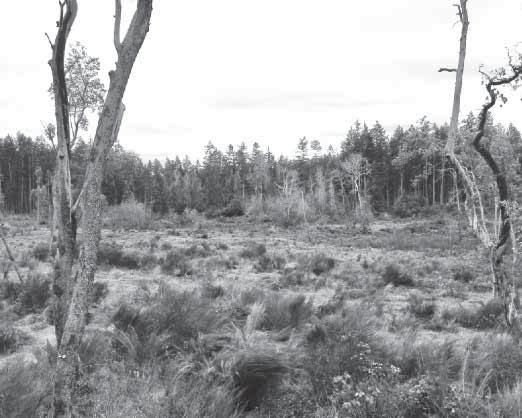
TAKE5 take5.ca 31
Kiwi Cove Community Garden volunteers. Photo submitted.
A Perfect Spring Trio
BY UTE HOLEWA MASTER GARDENER


As winter is drawing to a close here in our green and grey island paradise, I crave for a bit of colour, some eye candy. Early flowers can sustain themselves for well over a month and make us feel hopeful for a wonderful spring. Here are three spring beauties.
Corylus avellana “Contorta”
There’s a gnarly, twisted, woody shrub from which 7.6-centimetre golden catkins dangle, clumps of five-petalled flowers in subtle colours bowing their speckled heads like drifts of yellow or white trumpets announcing the return
of spring. This architectural wonder is commonly known as curly or twisted hazel, corkscrew hazel or Harry Lauder’s walking stick.

This is a multi-stemmed, slow-growing shrub, 2.4 to 3 metres high and wide, whose trunk, branches, twigs and even leaves are contorted. It is only the long pendulous male catkins that are straight; female flowers are red and much smaller. Twisted hazel is a sport (a spontaneous genetic mutation) of the hazel tree. Sports, are a growth abnormality, are usually sterile and can only be propagated by cuttings. As the twisted characteristic extends to the root system, these shrubs are usually grafted onto parent rootstock (sturdier). Therefore, prompt removal of straight suckers that emerge from the base of the shrub is key; otherwise, you will see your corky over-powered by its vigorous ancestors. Curly hazel requires minimal pruning but remove dead and diseased branches. Plant in nutrient rich, well-drained soil in full to partial sun. Water regularly until well established (about two years), and after that, the hazel should be drought tolerant, requiring watering only in prolonged periods of extreme heat.
Narcissus spp. and hybrids
Daffodils are everywhere in the Paci fic Northwest because they’re dependable, easy to grow and are deer, rabbit and rodent resistant. Did you know that the bulbs are toxic? These pretty, bright flowers, from yellow, salmon, white and bi-colour, range in size from 16 to 45 centimetres tall and 15 to 20 centimetres wide, blooming in early to late spring.
Daffodils are true bulbs, which means they go dormant from summer through winter and should be planted in the autumn to get their required period of


chill. Our predictable rains provide all the water they need in preparation for their spring show, and our dry summers are suitable for their requirements in the dormant season. Deadheading the flowers is fi ne, but don’t cut back the leaves until they’ve died back, as these provide nutrients to the bulb for next year’s show.
Hellebores x hybridus
These beautiful, evergreen perennials are perfectly suited to the Paci fic Northwest, needing water in winter and spring and are drought tolerant in summer once established. Their leathery, dark green, palmate leaves are lovely in their own right, but in late winter, a promise of colour is pushing its way out of the soil, undeterred by lingering snow. The flower buds continue to swell on top of sturdy 30- to 60-centimetre petioles until they fi nally unfurl between December and April, depending on the variety, revealing nodding flowers ranging in shades from cream, through red, green, purple to near black, with or without freckles.
Hellebores are reliable additions to any garden where there is full to partial shade. Under deciduous shrubs, they receive warm winter sun while being protected from hot sun in summer. Hellebores will settle into well-drained
Clockwise: Corylus avellana ‘Contorta’ Narcissus spp. and hybrids
Photos: Wikimedia Commons
32 take5.ca MARCH2023
organic soil for the long haul. They do not like being moved and seldom need division, although a lucky gardener may see seedlings appear, which are rare gems. Remove unsightly leaves as the flowers appear and deadhead flowers if you do not want them to “go forth and multiply.”





Certified Vancouver Island Master Gardeners are volunteers who provide education to the home gardener using current, science-based horticultural knowledge that exemplifies environmentally responsible practices and stewardship.











33
Hellebores x hybridus. Photo: Wikimedia Commons
A Glimpse of Spring
BY SASHA MARK

Spring at Wildwood is sort of magical. Longer days, warmer weather and plenty of rain make for perfect growing conditions. Fresh shoots pop up from the rich soil, and new buds appear, adding a burst of green to the shrubs and trees. Juvenile birds fledge, and young mammals emerge with their moms.

Last year, I experienced the most quintessential spring moment at Wildwood. As I stood on the trail in the woods, to one side of me, a nest of baby robins cried out to be fed, and on the other, a baby rabbit munched on a fresh blade of grass. It felt surreal. This occurred later in April; however, here are some sure signs that spring is in fact on its way.
I often fi nd that the fi rst sign of spring in the forest is the subtle change in the colour of bare shrubs. One day, the twigs shift from dark brown to a hazy green.
Soon after, the tth’uxwun’ shrubs spring to life.
Tth’uxwun’, according to Dr. Luschiim Arvid Charlie in Luschiim’s Plants is the Hul’qumi’num name for bird cherry (also commonly known as Indian plum). Light green oblong leaves burst forth soon, followed by drooping clusters of white flowers. The male and female flowers grow on separate shrubs, and in my experience, the male flowers have an interesting odour not unlike cat urine. The leaves smell like cucumber.
The smell of ts’a’kw’a’ also reminds me that soon warm weather will follow. This odiferous plant is one of the fi rst bursts of colour in the forest in the spring.
According to Dr. Luschiim Arvid Charlie, ts’a’kw’a’ is the Hul’qumi’num name for skunk cabbage or swamp lantern. He also says that when black bears wake up from hibernation, they gorge on the leaves and run through bushes to flush out all the worms. Although this works for bears, eating raw skunk cabbage is not recommended for humans.


Vancouver Island is home to many species of birds year-round, and spring brings out the songbirds in droves. Soon, swallows, warblers and rufous hummingbirds will return, joining their non-migratory brethren at Wildwood. Spring is a great time of year to begin birding, and it is as simple as putting up a bird feeder outside your window and waiting to see who shows up!
There are so many spring phenomena happening across the Island right now. As for me, I will be walking the forest, on the lookout for leaves, shoots, buds and birds that come with the changing of the season.

34 take5.ca MARCH2023
Juvenile Flicker. Photo:Jean-Luc Giroux











TAKE5 take5.ca 35
Making Sense of the Senses
 BY PAMELA WALKER
BY PAMELA WALKER
How do you know but ev’ry Bird That cuts the airy way, Is an immense world of delight, Clos’d by your senses five?

 — William Blake
— William Blake
When we decided to go camping last year, we knew our chickens would need a babysitter, so we recruited a city-folk friend. Unfortunately, while he was on this watch, a wind came up and down went the fence around the coop.
“Those chickens of yours are not very smart,” our friend said as he reported



the mishap. “It took me ages to get them back into their pen.”

Why did he think our chickens dumb? After all, they saw an escape route from their caged-in existence; they determined there was more food out there than in; and when chased, they ran away from the nitwit who was running after them with a garden rake. Had he only sprinkled some grain inside their enclosure, they would have happily returned to their pen.
We tend to compare our intelligences to other species, which is a shame, as the 19th-century poet William Blake reminds us. To do so is to miss out on an “immense world of delight[s].” Theirs is certainly a different country, if not a dif-
ferent world.
Looking out a window, we see a good portion of the light spectrum, but not all of it. Where we see a yellow dandelion or sun flower, bees and wasps see a white flower with a large ultraviolet bullseye. On the other end of the spectrum, a bed bug looking out the window would use its infrared vision to see things that we cannot.
If we see red-breasted robins and towhees out the window, they see themselves only in shades of blue and yellow. A spider sees and hears almost nothing but detects things by vibrations. It makes a web in order to extend its senses far beyond its own body.
An owl does not see colours, but with its asymmetrical ears, surrounded by a funnel of stiff feathers, it can hear the skittering of mice feet — a sound we cannot detect — and figure out where

36 take5.ca MARCH2023
Clockwise: Red-breasted Robin with Squirrel, Close up of Robin, and Blue Heron catching dinner. Photos: John Anderson
they are in both the vertical and horizontal plane. A snake “sees” a mouse by using the two pit organs on its face to detect the infrared radiation that emanates from all warm-bodied creatures. And a bat “sees” a mouse by directing high-frequency sound waves towards the mouse. We cannot hear this sound, as it is beyond what our ears are capable of hearing.







A mosquito wouldn’t be able to see what we see out a window, but with its “nose” and antennae, it can detect the carbon dioxide and heat a creature emits. It even has special senses to detect human sweat. A swan can also “see” Earth’s magnetic field, enabling it to know where north is and to sense when to start its migration.


A dog sees only blues and yellows but is able smell time. Like a game of memory, but with its snout, a dog’s nose can make predictions about the future. It can tell when it’s suppertime and when you are supposed to be home from work.
If there was a window underwater for an alligator or shark to look through, they could detect the electrical field left by a passing school of fish while a dolphin passing by emits sonar to fi nd a mate.
Indeed, there are animals with ears on their knees, eyes on their arms, and tongues all over their bodies.

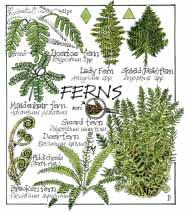
In his book An Immense World: How Animal Senses Reveal the Hidden Realms Around Us, science journalist Ed Yong teaches us not to judge other species against our five senses but rather to celebrate them all for their diversity and delight. If you read Yong’s book, you may never disparage a chicken — or even a mosquito — again.




TAKE5 take5.ca 37


Deer Hunter








TRAVEL ADVISORY: A state of war exists between gardeners and deer in the Yellowpoint / Cedar area. Extreme caution must be exercised until hostilities cease.
Let me explain. Like many wars, this one was started by an assassination attempt. No, not Fidel Castro; the CIA never fessed up. It was me the deer were after. Not since Todd Bertuzzi clobbered Steve Moore from behind with his hockey stick have we seen such a targeted hit.


It was 10:15 on a beautiful summer morning. Visibility: no further than the eye can see. I was cycling along my usual route, down Quennell Road, out to the Chuckwagon store and back. The road was straight and deserted, with forest on both sides. Birds chirped, frogs croaked, and bears shit in the woods (the exception being the one I just passed rooting through a garbage can. But that’s another story.)
Then, like a heat-seeking missile, a deer rocketed out from behind a large rock and headed straight for my front wheel. I





























sounded the general alarm by screaming from the top of my lungs, jammed on the brakes, made amendments to my will, filed my taxes, took out the garbage, and phoned my wife to tell her I’d be late for lunch. It’s amazing what you can get done when time stands still.
I also yelled, “Clear the bridge. Dive! Dive!” Too many WW2 movies I guess.
Fortunately, superior brakes saved the day. The deer went by with maybe a quarter inch to spare. Some of you might chalk up the incident to deer having the road sense of a zucchini. If their eyes weren’t mounted on the sides of their head, this would be easier to buy.
How could he have not seen me? I was decked out with the latest in anticollision wear. Lime green cycling shoes. Shoes so bright, so ugly, even the guys in the bike shop wouldn’t wear them, and they’ll wear anything. (Okay, they were on sale.)
No, this was a targeted hit. A hit made to look like an accident: just another skinny old guy falling off his bike. I got a close look at that deer’s eye. It was the eye of a hired killer.



Humans and deer have been at each other ever since plants started to go missing in the Garden of Eden. It was only a matter of time that the cold war would turn hot. Me and the deer were at war.
Initially, we tried the natural predator trick to frighten them away. We sprinkled powdered coyote dandruff on the leaves of garden plants. When that didn’t work, we tried freshly squeezed Bengal tiger

urine at $100 per litre. (Dangerous job collecting tiger urine.) Around that time, to save money, I started to think of myself as a natural predator and urinated on the more expensive plants. This didn’t work either, but it did make me chuckle every time a deer ate one of the anointed plants.
Next, my wife and I invested in motion detectors which activated, among other noises, a barking dog sound, my wife in full scream (expletives not deleted), and a Bengal tiger yelling in a loud angry voice, “Stop! Thief! Grow your own!” One variant also set off sprinklers. This worked as well as using a bird bath to keep away the robins. It did, however, infuriate the cat who also started urinating, but on the couch, not the plants.
All I knew, it was time to go on the offensive. But first I needed a fifth column behind enemy lines, someone who could find out what those deer were up to. According to the Internet, a Whippet with the right makeup was a dead ringer for a deer, especially if mounted on stilts.
Toby, the dog next door, wasn’t too happy with the assignment, but once he mastered the stilts and accepted the mascara, made a convincing deer. This disguise worked fine until Toby, chatting up a cute doe named Deirdre, blew his cover by admitting he chased cars as a hobby. There was also the matter of his long tail to consider.
Before being rebuffed outright, he did discover the cause of the attempted










40 take5.ca MARCH2023
assassination. It was the fence I built around our garden two years ago. A fence they’ve been unable to overcome. Deer, as it turns out, are sore losers.
The die was cast. If they wanted war, war it would be. My first stop was Cabela’s for the latest in camouflage sleepwear. You don’t want to be aroused by the sound of munched roses only to have your position revealed by moonlight reflecting off your pasty white belly. While you’re at it, don’t forget camo socks, and it always pays to accessorize with a few plants strapped to the sides of your head.
The salesman, who for some reason was also wearing camo pajamas, was quite upfront in advising against firearms. “Too hard on the neighbours when you miss,” he warned. Besides, I was on Cabela’s Do Not Sell list, the result of a pellet gun incident where I peppered a black bear’s rump while she was going through the neighbour’s garbage can. Unfortunately, the bear turned out to be Betty bending over in a dark housecoat.
Cabela’s recommended mounting ¾-hp meat grinders on the fence every 30 feet or so. “No deer wants to tangle with one of our meat grinders, especially if it comes with the sausagemaking attachment.”
Unfortunately, that solution was expensive, so I developed my own trap, cleverly designed from existing technology: the Bambinator Garden Pro, available in participating Canadian Tire stores as soon as they stop laughing. Basically, it’s the big wooden box that my hot tub came in, propped up by a stick with a string attached. For bait, any expensive potted plant will do.
That’s why you haven’t seen much of me lately. Until this crisis is over, I’ll be out in our backyard, disguised as an azalea waiting to pull the string. Betty from next door said it’s a good place for me – safer for everyone, including the wildlife.

Wine of the Month
BY GORD JOHNSON
Chenin Blanc.
¿qué es esta
C’est what?!?





This white wine grape variety has a mixed reputation, but I will call it noble. It has found a home -- outside of it’s home, the Loire Valley in northern France -- in South Africa.
Bits and pieces elsewhere, including our beloved Okanagan Valley. Inniskillin does a superb example year after year, age-worthy as well, surprise surprise.
Biggish, usually with great balancing acidity, food-worthy, sip-worthy, with aromas and flavours that are challenging to corner.
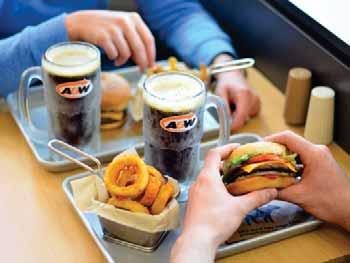
Start with the South Africans . . . Wild Olive and Spier . . . Salud!
Pick up a copy of Delbert’s Slightly Corked for some great reading. $20 at the Mahle House, and the TAKE 5 office. What a deal! Slightlycorkedandmore.wordpress.com

TAKE5 take5.ca 41
FOR SALE
FISH FISH FISH. Buy direct from the guy who caught it! High-quality salmon, lingcod, rock fish. All fish blast frozen at sea. Satisfaction guaranteed! Contact Jim at oceandancer. wallace@gmail.com or 250-245-5957/250-7391123.
WANTED
IN SEARCH OF A 14FT–16FT FOOT CLINKER BOAT in any condition. Must have an inboard shaft. Contact Brian at 250-268-0227
FOR RENT
DOWNTOWN LADYSMITH APARTMENT. Newer, 2nd floor, fully furnished, open-concept design. Large master bedroom with queen, 10ft closets, linens and kitchen wares included. $1,795 per month, includes utilities. Available April 1. Call 604-880-2538.
FARM FRESH
EMPRESS ACRES LITTLE FARM STORE. Pasture-raised: roasting chickens endMarch; pork sides-sale at $4.90/lb; comfort food boxes, specialty sausages, bacon, ind. cuts, eggs, vegetables & more; open 7 days/ wk; 2974 Haslam Rd. www.empressacres. ca. Email marlene@empressacres.ca; for pork sides & boxes, call or text Simon at 604-578-0646
ACTIVITIES
TAKE 5 offers non-profits discount rates to help promote their events. ads@take5.ca


DUPLICATE BRIDGE. Join us at the Cedar Heritage Centre, 1644 Macmillan Rd., Cedar, on Tuesdays at 12:45pm. Cost $5 per session. Everyone welcome; come alone or with a partner. Info 250-390-3773.
CRAFT FAIR. Every Sunday Carol’s Artisans: wood turned pens, quilting, woodworking, amazing sewing and knitting, interchangeable jewelry, hats, pottery, preserves, jams and MORE. 13467 Cedar Rd. 10am–3pm. New vendors welcome. Contact petespenandmore@shaw.ca.
HEALTH & WELLNESS
TAI CHI for mental & physical health. Beginner class Monday mornings. Ongoing class every Wednesday morning. For class time and location and more information, visit www.taichinanaimo. org or call Sara 250-245-1466.
HEALTH CARE ASSISTANT with over 20 years experience available to provide care aid, palliative care, home help, run errands, drive to appointments, gardening and cleaning. Text or leave a message. Jan @ 250 701 2909
BUSINESS
I CAN EDIT. Copy editing, proofreading, structural editing and more. Fiction or nonfiction, web content and eBook prep. For more information, editican@gmail.com.
EVENT PLANNING. Do you have an event coming up and need someone to plan, organize and take care of all the details? Experience with non-profits, businesses and personal events. Certified event planner. Contact Elly at ellybythesea@gmail.com.
HOME & YARD
KB HANDYMAN AND YARD WORKS. Minor carpentry work, decks, fences, power washing, tree pruning, yard clean up, lawn fertilizing, mowing. Seniors discount. Contact Karl kbhandymanandyardworks@ gmail.com or 250-714-2738.
ALL ACRES providing all aspects of tree work. Pruning, falling, hedging, dangerous tree removal. Fully insured. Professional work at reasonable rates. Call 250-246-1265.
MAKE IT NICE qualified, experienced, gardening and small fruit tree pruning. Available for private, residential gardens. Please call 250-754-9346.
CONCRETE RESULTS. Foundations, retaining walls, patios, driveways, walks and stairs. Full forming and finishing. 40 years’ experience. Email Gord at concreteresults@ live.com.
DARRELL ESSAR RENOVATIONS. Over 35 years’ experience, certified journeyman carpenter. Renovations For free estimate, call Darrell 250-714-3823.
ISLAND PRUNING. Professional tree care from large scale orchards to budding new trees. I can meet any pruning need. Shrubs, vines and ornamental. Large & small clean ups. Call Darcy Belcourt 250-323-1260.
PLUMBING SERVICES. Journeyman Red Seal Plumber with over 30 years’ experience for repairs, leaks, installations or renovations. Free estimates and reasonable rates. Call Joe (leave a message) or text 250-246-5883.
HEART LAKE ROOFING for all your roofing repairs 250-668-9195.
MUSIC & ARTS
Acoustic Folk Band Summer Week August 7 – 11 for Fiddles, Mandolin, Guitar, Ukulele, Bass, Cello, Whistle, Viola, Flute, Harp. 9:00 – 10:00 am at Trinity Church, 6234 Spartan Rd. North Nanaimo, off Metral Drive. Offered as part of Fiddle Camp Week. For ages 10 + Cost: $75 Possible carpools from Ladysmith. Contact: nanaimofiddlesociety@ gmail.com or 250 – 268 – 6064 or https:// nanaimofiddlesociety.square.site
PETS
PROFESSIONAL PET CARE SERVICE. “Leash ’em & walk ’em” with Marlena. I have Animal First Aid, CPR and criminal record check. My service for all pets includes dog walking, home care visits, overnight in your home and much more. As my love is yours! Call 250-246-9368.
The PET NANNY is back. I have cared for animals for the last 7 years. I offer overnight care at your home or daily home visits for pets or home security. Email sburchard@hotmail.ca or call 250-9248809.
WHAT’S HAPPENING
ST. MARY’S CATHOLIC CHURCH Do you feel the world, your family or health is in a desperate situation and you want to do something?
Everyday at 3pm until April 1, people of good will, are journeying to St. Mary’s Catholic Church to pray for 15 minutes for God’s mercy. Come adore!
March 7 – 31 Tuesdays & Fridays - 8 postpartum rehab sessions. Focus is on breath work, diaphragm and pelvic floor activation, postural strengthening, glute strength and total body conditioning. 2 – 3pm with Dr. Ashley Wincikaby, hello@viphysiotherapy.com 250-245-3444
42 take5.ca MARCH2023























































































































































 BY ELLY SMITH
BY ELLY SMITH


















 BY DALYS BARNEY
BY DALYS BARNEY






















































































 BY PAMELA WALKER
BY PAMELA WALKER

 — William Blake
— William Blake
























































































